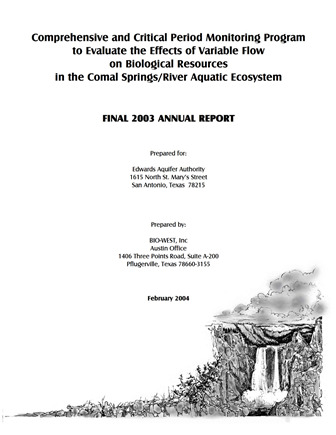Comprehensive and Critical Period Monitoring Program to Evaluate the Effects of Variable Flow on Biological Resources in the Comal Springs/River Aquatic Ecosystem Final 2003 Annual Report

| Summary |
|
The purpose of this report is to document the results of all aquatic ecosystem monitoring conducted in 2003 at Comal Springs located in New Braunfels, Texas. The monitoring and report preparation was performed by BIO-WEST, Inc. Pflugerville, Texas. [Excerpted from the Executive Summary\ In 2003, flows remained high through the summer and did not follow the typical pattern of decline. In 2003, flows remained high through the summer and did not follow the typical pattern of decline…. Baseline data have continued to show that the Comal River is an ecosystem with high water quality according to the chemical and physical variables that were measured. After the scouring effects of floods in both 2001 and 2002, many vegetation types responded with rapid re-growth and expanded to a total coverage that was far greater than in previous samples. For the most part, these increases in vegetation coverage were maintained throughout 2003. However, there was some decline in coverage that occurred in the fall of 2003 in many reaches despite the high flows and presumably favorable conditions. This emphasizes the fact that conditions are dynamic even when flows remain relatively constant and habitat should not be predicted on flows alone…. One of the more important observations with vegetation composition in 2003 was the dramatic shift in habitat within the Old Channel Reach. Prior to 2003, filamentous algae dominated this reach and provided the highest quality habitat (supported the greatest density) for fountain darters. Beginning in the fall of 2002 Hygrophila and later Ludwigia appeared in the reach and have grown significantly in 2003 to nearly complete coverage of areas that had previously supported filamentous algae…. In previous years, the greatest number of fountain darter observations occurred in the spring and the fewest in the fall, but that trend was reversed in 2003. Two areas of additional concern to fountain darters, the density of giant ramshorn snails (Marisa cornuarietis) and evidence of gill parasites on fountain darters, were monitored in 2003. By all indications the densities of giant ramshorn snails observed in the Comal ecosystem during the study period to date (including the 2000 low-flow events) pose no serious threat to the aquatic vegetative community (i.e., fountain darter habitat). However, because of the impact that this exotic species can have under heavier densities, close monitoring of this species should continue. Gill parasites were found on fountain darters in varying densities among different sample areas and appear to be concentrated in areas with slow-moving water and high snail densities…. It is difficult to evaluate the influence of springflow on the abundance of invertebrates found in the net because discharge remained so similar among the three sample events in 2003, however, some interesting patterns emerged…. Comal Springs salamanders were observed in each [Spring Island ] area during each sampling event. In 2003, stable flows reduced the sediment accumulation and more salamanders were observed in the Spring Run 3 sample area. As documented via SCUBA surveys, the Comal Springs salamander population was maintained in the deeper portion of Landa Lake throughout the study period. … More data from lowflow periods (particularly from an extended low-flow period) are essential to fully evaluate the biological risks associated with future critical periods (high or low flow)…. This study remains the most comprehensive biological evaluation that has ever been conducted on the Comal River ecosystem. |
Search for Documents
Advance Search
Explore EAA's Scientific Reports
- All Reports
- Geomorphology and Caves
- Weather Modification
- Geology
- Water Use and Conservation
- Geochemistry
- Water Resources Planning and Management
- Floods and Drought
- Water Quality
- Climatology
- Surface Water / Groundwater Relationship
- Biology
- Springs, Groundwater Discharge
- Archaeology
- RZ Protection
- Aquifer Levels
- Remote Sensing
- Precipitation
- Overview Studies
- Modeling
- Hydrology and Hydrogeology
- History
- Groundwater Recharge, Recharge Zone
- Groundwater Movement
